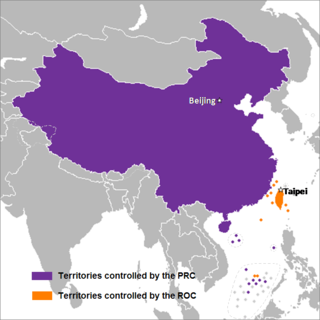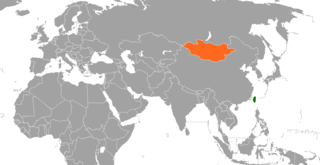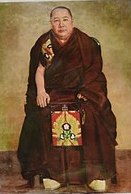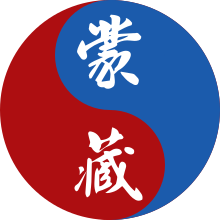
Chinese unification, also known as Cross-Strait unification or Chinese reunification, is the potential unification of territories currently controlled, or claimed, by the People's Republic of China and the Republic of China ("Taiwan") under one political entity, possibly the formation of a political union between the two republics. Together with full Taiwan independence, unification is one of the main proposals to address questions on the political status of Taiwan, which is a central focus of Cross-Strait relations.
The Executive Yuan is the executive branch of the government of the Republic of China (Taiwan). Its leader is premier, who is appointed by the president of the Republic of China (ROC) and serves as the head of government.
The Mainland Affairs Council (MAC) is a cabinet-level administrative agency under the Executive Yuan of the Republic of China (Taiwan). The MAC is responsible for the planning, development, and implementation of the Cross-Strait relations policy which targets mainland China, Hong Kong and Macau.

Amban is a Manchu language term meaning "high official", corresponding to a number of different official titles in the imperial government of Qing China. For instance, members of the Grand Council were called Coohai nashūn-i amban in the Manchu language and Qing governor-generals were called Uheri kadalara amban.

The Ministry of Culture is the ministry of the Republic of China (Taiwan) that promotes cultural and creative industries. The ministry also maintains the National Repository of Cultural Heritage.
The Lifan Yuan was an agency in the government of the Qing dynasty of China which administered the empire's Inner Asian territories such as Mongolia and oversaw the appointments of Ambans in Tibet. Until the 1860s, it was also responsible for the Qing's relations with the Russian Empire.
Mongolians in Taiwan form a small portion of the island's population. Labour migration from Mongolia to Taiwan began in 2004.

At its establishment in 1912, the Republic of China claimed to be the successor state to the entirety of the Qing empire, which included Outer Mongolia. The Republic of China did not recognize Outer Mongolia until 1945; neither country exchanged diplomats between 1946 and 1949. At the end of the Chinese Civil War in 1949, Mongolia recognized the People's Republic of China and the Republic of China retreated to the island of Taiwan. The Republic of China continued to show Mongolia as part of its territory on official maps until 2002 when they recognized Mongolia as an independent country, and informal relations were established between the two sides.
The Golden Urn is a method for selecting Tibetan reincarnations by drawing lots or tally sticks from a Golden Urn introduced by the Qing dynasty of China in 1793. After the Sino-Nepalese War, the Qianlong Emperor promulgated the 29-Article Ordinance for the More Effective Governing of Tibet, which included regulations on the selection of lamas. The Golden Urn was introduced ostensibly to prevent cheating and corruption in the selection process but also to position the Qianlong Emperor as a religious authority capable of adducing incarnation candidates. A number of lamas, such as the 8th and 9th Panchen Lamas and the 10th Dalai Lama, were confirmed using the Golden Urn. In cases where the Golden Urn was not used, the amban was consulted. Golden Urn was exempted for Lhamo Dhondup to become the 14th Dalai Lama in 1940.

Tibet was a de facto independent state in East Asia that lasted from the collapse of the Manchu-led Qing dynasty in 1912 until its annexation by the People's Republic of China in 1951.
The Changkya Khutukhtu was the title held by the spiritual head of the Gelug lineage of Tibetan Buddhism in Inner Mongolia during the Qing dynasty.

The Mongolian and Tibetan Cultural Center is a cultural center in Da'an District, Taipei, Taiwan under the administration of the Ministry of Culture. It was previously under the Mongolian and Tibetan Affairs Commission of the Executive Yuan, which in 2017 had its duties absorbed into the Ministry of Culture and the Mainland Affairs Council's Department of Hong Kong, Macao, Inner Mongolia, and Tibet Affairs.

Lobsang Pelden Tenpe Dronme was a clergyman of the Gelug School of Tibetan Buddhism and the 7th Changkya Khutukhtu. He was the highest person of Tibetan Buddhism in Inner Mongolia and the fourth highest lamas of Tibetan Buddhism in general. He supported the Kuomintang and accompanied the Republic of China Government to Taiwan after the Chinese Civil War in 1949. He was awarded titles by the Kuomintang and also received living expenses until his death.

The Tibet Area was a de jure province-level administrative division of the Republic of China which consisted of Ü-Tsang and Ngari areas, but excluding the Amdo and Kham areas. However, the Republic of China never exercised control over the territory, which was ruled by the Ganden Phodrang government in Lhasa. The People's Republic of China, which overthrew the ROC on the mainland in 1949, invaded Chamdo in 1950 and de facto incorporated the Dalai Lama-controlled regions in 1951. After the 1959 Tibetan rebellion, the State Council of the PRC ordered the replacement of the Tibetan Kashag government with the "Preparatory Committee for the Tibet Autonomous Region" (PCTAR). The current Tibet Autonomous Region was established as a province-level division of the People's Republic of China in 1965.
Hsu Cheng-kuang is a Taiwanese politician. He was the Minister of the Mongolian and Tibetan Affairs Commission (MTAC) of the Executive Yuan in 2000–2002.
The administrative divisions of China between 1912 and 1949 were established under the regime of the Republic of China government.

Changkya Rölpé Dorjé (1717-1786) was a principal Tibetan Buddhist teacher in the Qing court, a close associate of the Qianlong Emperor of China, and an important intermediary between the imperial court and Inner Asia. He also oversaw the translation of the Tibetan Buddhist canon into Classical Mongolian and Manchu. He also was involved in the compilation of a quadrilingual set and supervised the translation from Chinese into Manchurian, Mongolian and Tibetan of the entire Śūraṅgama Sūtra completed in 1763; the Tibetan translation is currently preserved in a supplement to the Narthang Kangyur.

The Bureau of Buddhist and Tibetan Affairs, or Xuanzheng Yuan was a government agency of the Mongol-led Yuan dynasty of China to handle Buddhist affairs across the empire in addition to managing the territory of Tibet. It was originally set up by Kublai Khan in 1264 under the name Zongzhi Yuan or the "Bureau of General Regulation", before it was renamed in 1288.

Kao Su-po is a Taiwanese politician, professor, and public servant. He was a member of the Legislative Yuan from 2005 to 2008, and led the Mongolian and Tibetan Affairs Commission between 2008 and 2011. He contested the Tainan mayoralty in 2018, losing the office to Huang Wei-cher.

Meidaizhao Monastery or Meidaizhao Lamasery is a Tibetan Buddhist temple located in Tumed Right Banner, Baotou, Inner Mongolia, China.















